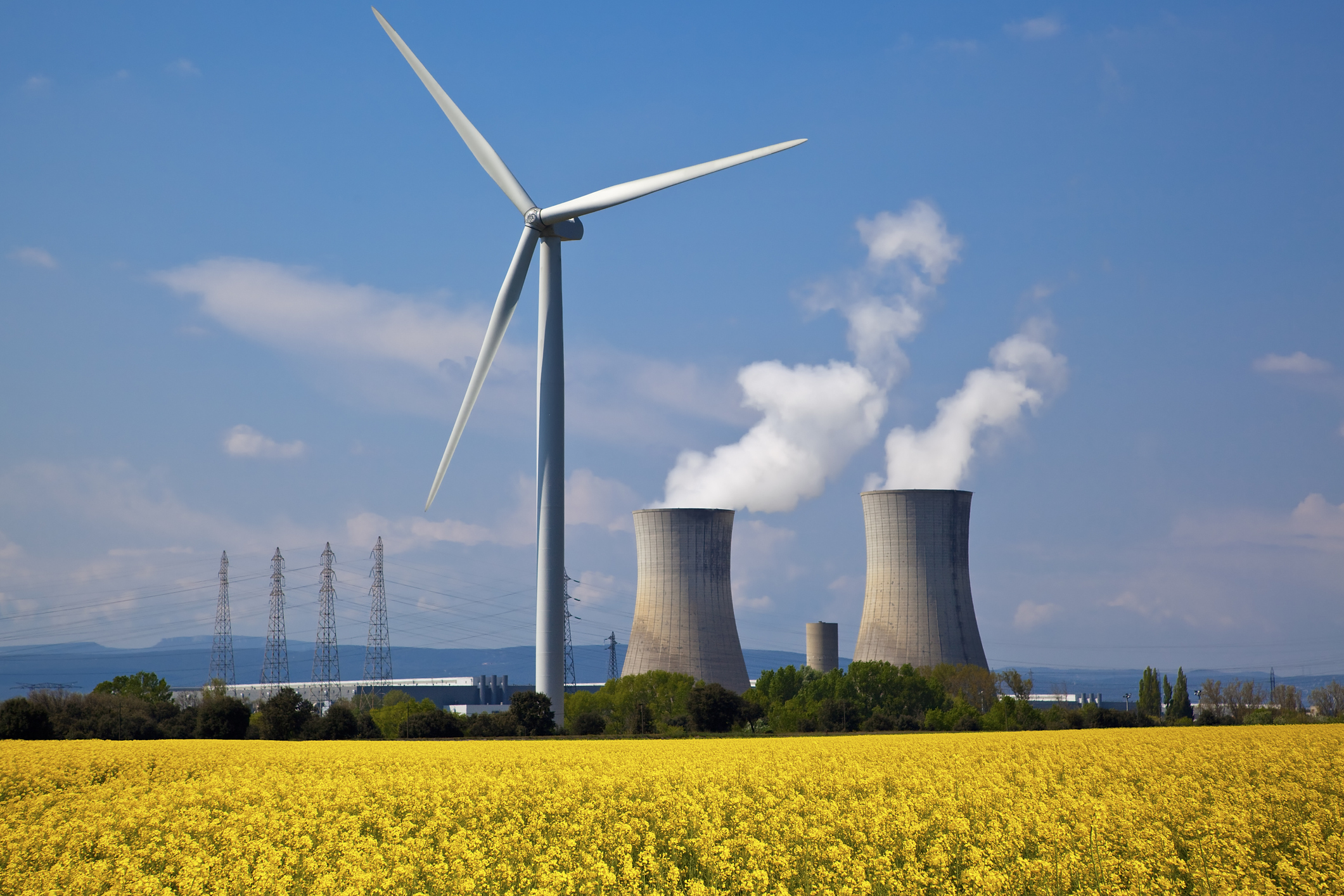How to invest in nuclear power
We need nuclear power to go green, says Dominic Frisby. But there is a better option than huge power stations


I don’t know about you, but I use artificial intelligence (AI) all the time. ChatGPT has become my right-hand man. It gives me advice (really – and good advice too), it helps me make decisions, it gives me exercise workouts and recipes; it proofreads what I write, it helps me write titles, it even helps me write song lyrics. Midjourney does all the imaging for my newsletter. Even a simple Google search now involves lots of AI. I know I’m not alone. Almost everyone is using AI, consciously or not.
But AI requires bucketloads of power. That’s why Microsoft recently agreed to pay Constellation Energy, the new owner of America’s infamous nuclear power station, Three Mile Island, a sizeable premium for its energy. There is cheaper wind and solar power to be had in Pennsylvania, but it isn’t as reliable as nuclear 24 hours a day.
It’s not just AI. The widespread political desire to rid ourselves of fossil fuels means the world needs electricity, and fast.
MoneyWeek
Subscribe to MoneyWeek today and get your first six magazine issues absolutely FREE

Sign up to Money Morning
Don't miss the latest investment and personal finances news, market analysis, plus money-saving tips with our free twice-daily newsletter
Don't miss the latest investment and personal finances news, market analysis, plus money-saving tips with our free twice-daily newsletter
Nuclear is the solution, of course. But nuclear takes a lot of time, even with AI now “re-routing” the anti-nuclear narrative. It takes especially long in the UK, where any kind of infrastructure project requires billions to be spent on planners, lawyers and consultants before a brick is even lifted.
It’s absurd. Nuclear power stations have been operating commercially for 70 years, providing reliable, affordable and almost infinitely renewable “clean” electricity. Nuclear has the best safety record of any energy technology. Almost all environmental concerns, such as waste disposal, have been solved. It has taken so long for this narrative to change because activists have, for so many years, insisted to the public, politicians and the media that nuclear energy is unsafe that the notion has become firmly entrenched.
The narrative around nuclear power is changing
Layer upon layer of safety is demanded in nuclear plant design. The regulatory process is slow, cumbersome and complex. There is a long lead time between planning, building and operation, which adds to expense. Political uncertainty meant many proposals for nuclear power stations in the UK were shelved. It all drives away investment.
But governments around the world are waking up to the fact that the silver bullet is nuclear-powered. Thus the narrative is changing. The dawn of the new age of nuclear power is upon us and it can’t come quickly enough. However, it still takes a long time to design and build a nuclear power station.
That’s why the focus has shifted to small modular reactors (SMRs). These have been operational for almost 70 years now in submarines, aircraft carriers and ice-breakers, but in the last few years land-based SMRs have been developed to generate electricity. They are a huge potential problem-solver.
They use simple, proven technology, and are safer than current nuclear power stations. They can be manufactured in factories and then rapidly erected on-site. Modular refers to the design principle of breaking down a system into small, independent and interchangeable components, or “modules”, that can easily be combined, modified or replaced without affecting the rest of the system. This flexibility means they are scalable. It aids manufacture, transportation and installation while reducing construction time and costs.
SMRs don’t occupy much land, so they have little impact on the landscape. Some can even be constructed underground – surely preferable to wind turbines and solar farms. In the UK, they could be erected on the redundant sites of closed nuclear and coal-fired power stations, where grid connections are readily available.
A 440 megawatt (MW) SMR would produce about 3.5 terawatt hours (TWh) of electricity per year – enough for 1.2 million homes, or to provide power to Wales, the Northeast of England or two Devons. That would require about 25 acres of land. A solar farm would need 13,000 acres for the same output; a wind farm, 32,000 acres. Three 440MW SMRs would be enough for London, which has around 3.6 million homes.
What’s more, their output is not dependent on the weather. That’s why Microsoft paid a premium of more than 85% for Three Mile Island’s power. SMRs also produce electricity that can easily be adjusted to meet the constant, everyday needs of the grid (baseload), and they can also ramp up or down to follow changes in demand throughout the day. They spin in sync with the grid, so they help keep everything stable. When they’re running, they act like a steady hand, providing momentum that makes it easier to manage sudden changes in electricity supply or demand.
How to invest in nuclear power
There are all sorts of ways to invest in nuclear power. The simplest and least risky is to buy the metal itself. Current demand for uranium stands at around 200 million pounds per year, while mining output totals only 140 million pounds. Another 25 million pounds comes from secondary sources, such as scrap and recycling. So there is a supply deficit. I’m surprised the price isn’t higher. London-listed Yellow Cake (Aim: YCA) has been set up with this purpose in mind. It is, essentially, a uranium holding company. You buy the shares and thus own a share of the uranium it holds.
You could also buy uranium miners. There are large producers, such as Cameco (Toronto: CCO) and Paladin Energy (Sydney: PDN). You can also gain exposure via large caps, such as Rio Tinto (LSE: RIO), but they are not pure plays. There are mine developers too, such as NexGen Energy (Toronto: NXE), whose Rook 1 project should be producing a whopping 30 million pounds a year by 2030, almost enough to solve the uranium supply deficit single-handedly.
If you don’t fancy your stock-picking skills, go for a fund instead. The London-listed Sprott Uranium Miners ETF (LSE: URNP) is an exchange-traded fund that gives you exposure to a basket of mining companies, as does the closed-end fund Geiger Counter (LSE: GCL). Another popular ETF is the Global X Uranium UCITS ETF (LSE: URNU).
Are miners a good investment?
I do not like the miners at all. About 90% of those listed in the funds do not have any production coming in the near future and are, therefore, huge vortexes into which capital will disappear. At present, they are fully valued. That’s not to say they won’t go up. But when the time comes for them to fall, they will bomb.
Both Rolls-Royce (LSE: RR) and Fluor Corp (NYSE: FLR) have been real winners. Rolls-Royce has built seven generations of SMRs for use in nuclear submarines and, with its modern designs for SMRs, has been winning contracts all over. Rolls-Royce is not a pure SMR play. But it has put its SMR business into a separate entity (Rolls-Royce SMR) and I presume this will be spun out and listed at some stage.
The stock has been going great guns under its new CEO, Tufan Erginbilgiç, and it’s been a real winner. It’s now at 530p and there’s no stopping it. It was 1,350p in 2013, so there’s plenty of upside left, and that was before there was any urgency about SMRs.
Majority shareholder and engineering company Fluor Corp has been a real winner too. It’s now $50. The stock remains a hold, although it is not a pure play. Worth $8.6 billion, Fluor has $200 million of free cash flow and trades at 42 times earnings.
A new listed player
But the company we were looking at, NuScale Power Corporation (NYSE: SMR), has now listed – good ticker – and you can buy the stock at not far off the flotation price. Be warned, however: this is a volatile company. Since its initial public offering (IPO) at $10, the stock has been as high as $15 and as low as $2. It is now at $13.
NuScale designs, develops and commercialises SMR reactors for nuclear-power generation, aiming to provide a “safe, flexible and scalable nuclear-energy solution”. Its flagship product is the NuScale Power Module, a self-contained pressurised water reactor (PWR) that is far smaller than traditional nuclear reactors. Each module has an electric capacity of about 60 megawatts, but they can combine to scale up.
NuScale has partnered with various organisations, including the US Department of Energy (DOE) and global energy firms, but it does not yet have a solid sales pipeline, so it is hard to value. Instead, it’s a bit of a meme stock that rises and falls when it gets tipped. Nuscale has a market capitalisation of $1.2 billion and revenues of $23 million; it lost $273 million last year. It now has $180 million in negative free cash flow, $130 million in cash and a burn rate of about $35 million per quarter. (So it’s got enough money for another year.) Caveat emptor.
Another option is BWX Technologies (NYSE: BWXT), but again it’s not a pure SMR play, more of a picks-and-shovels play. The company manufactures nuclear reactor components, systems fuel and other critical parts for the nuclear power industry. It really is wide-ranging (think anything from naval nuclear propulsion to nuclear defence) and its history goes all the way back to the Manhattan Project.
SMR developers will often rely on BWX’s expertise and manufacturing capabilities to ensure the safety and functionality of their designs. As demand for SMRs grows, so will the appetite for BWX’s products and services. BWX has a market value of $10 million and $1.2 billion in debt. Earnings per share are just shy of $3, and the price/earnings (p/e) ratio is close to 40. But it is profitable and pays a yield just below 1%.
If you want to go really small and speculative, there is always the mining exploration option (not recommended), or uranium enrichment firms. If this technology of enriching uranium to make it more powerful becomes good, then the efficiencies of the industry will improve even further, and the problem of uranium supply deficits will quickly vanish, along with the high prices of many uranium miners. Silex Systems (Sydney: SLX) – market cap A$1.1 billion (£565 million), 50% owned by Cameco – is the market leader here, although Centrus Energy (NYSE: LEU), worth $1 billion, is not far behind.
We are still some years from successful enrichment, but it is coming. I doubt we will see it before the uranium price itself breaks to new highs above $140/lb, which it hit in 2006, and probably not until $200 uranium. High prices have a habit of accelerating everything. Uranium is now at $70/lb.
That’s when tiny-cap nuclear-fuel tech firms such as Lightbridge (Nasdaq: LTBR), worth $46 million, could rocket. Lightbridge, looking to improve the safety, economics and proliferation resistance of nuclear power, is developing a fuel that operates about 1,000 degrees cooler than standard fuel. It’s got $27 million in the bank, is losing $10 million a year and, like NuScale, seems to rely on memes and tipsters. The stock costs $3 so there is plenty of upside. But be warned: this is an illiquid Nasdaq stock. Don’t chase it.
This article was first published in MoneyWeek's magazine. Enjoy exclusive early access to news, opinion and analysis from our team of financial experts with a MoneyWeek subscription.
Get the latest financial news, insights and expert analysis from our award-winning MoneyWeek team, to help you understand what really matters when it comes to your finances.
Dominic Frisby (“mercurially witty” – the Spectator) is as far as we know the world’s only financial writer and comedian. He is the author of the popular newsletter the Flying Frisby and is MoneyWeek’s main commentator on gold, commodities, currencies and cryptocurrencies. He has also taken several of his shows to the Edinburgh Festival Fringe.
His books are Daylight Robbery - How Tax Changed our Past and Will Shape our Future; Bitcoin: the Future of Money? and Life After the State - Why We Don't Need Government.
Dominic was educated at St Paul's School, Manchester University and the Webber-Douglas Academy Of Dramatic Art.
You can follow him on X @dominicfrisby
-
 Six steps business owners should consider before April inheritance tax relief change
Six steps business owners should consider before April inheritance tax relief changeNew limits to inheritance tax-free allowances are coming in from the Spring that affect business owners. Those looking to sell or transfer their assets into a trust before the changes need to act now
-
 Edinburgh Worldwide shareholders reject Saba proposals
Edinburgh Worldwide shareholders reject Saba proposalsToday’s requisitioned general meeting of Edinburgh Worldwide shareholders has ended in another defeat for activist investor Saba Capital management
-
 Profit from pest control with Rentokil Initial
Profit from pest control with Rentokil InitialRentokil Initial is set for global expansion and offers strong sales growth
-
 Three funds to buy for capital growth and global income
Three funds to buy for capital growth and global incomeOpinion Three investment trusts with potential for capital growth, selected by Adam Norris, co-portfolio manager of the CT Global Managed Portfolio Trust
-
 Fine-art market sees buyers return
Fine-art market sees buyers returnWealthy bidders returned to the fine-art market last summer, amid rising demand from younger buyers. What does this mean for 2026?
-
 PayPoint: a promising stock for income-seekers
PayPoint: a promising stock for income-seekersPayPoint, a household name across Britain, is moving away from its traditional roots toward a digital future. Investors after a steady income should buy in
-
 Investing in forestry: a tax-efficient way to grow your wealth
Investing in forestry: a tax-efficient way to grow your wealthRecord sums are pouring into forestry funds. It makes sense to join the rush, says David Prosser
-
 The MoneyWeek investment trust portfolio – early 2026 update
The MoneyWeek investment trust portfolio – early 2026 updateThe MoneyWeek investment trust portfolio had a solid year in 2025. Scottish Mortgage and Law Debenture were the star performers, with very different strategies
-
 Nobel laureate Philippe Aghion reveals the key to GDP growth
Nobel laureate Philippe Aghion reveals the key to GDP growthInterview According to Nobel laureate Philippe Aghion, competition is the key to innovation, productivity and growth – here's what this implies for Europe and Britain
-
 Pundits had a bad 2025 – here's what it means for investors
Pundits had a bad 2025 – here's what it means for investorsThe pundits came in for many shocks in 2025, says Max King. Here is what they should learn from them
